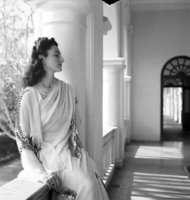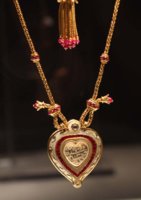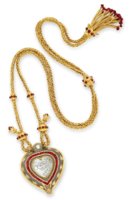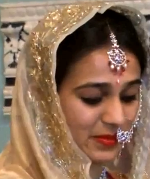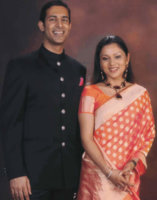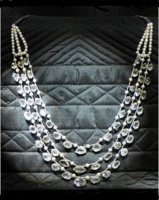You are using an out of date browser. It may not display this or other websites correctly.
You should upgrade or use an alternative browser.
You should upgrade or use an alternative browser.
Royalty & their Jewelry
- Thread starter Japster
- Start date
More options
Who Replied?
Last edited:
The Taj Mahal/Nur Jahan Diamond
The historic 17th-century, heart shaped table cut Indian diamond leaves no doubt about the date of origin of the diamond and its original owner. The inscription reads "Nur Jahan Begum Padshah; 23; 1037" .Thus the original owner of this diamond and jade pendant was Empress Nur Jahan wife of Mughal Emperor Jahangir . The Nur Jahan diamond and jade pendant subsequently came to be known as the Taj Mahal diamond and jade pendant probably because it was earlier believed to be a gift by Emperor Shah Jahan himself to his beloved wife Mumtaz Mahal and just as much as the Taj Mahal was a symbol of Shah Jahan's undying love for Mumtaz Mahal the heart shaped diamond and pendant was also believed to be a memento of the Emperor's eternal love for his beloved wife.
The Taj Mahal diamond is a heart shaped tablecut flat diamond known technically as Lasque. The table cut or lasque is an ancient Indian cut in which the diamond was cut in the form of a thin slab or sheet of different shapes and sizes such as rectangular, square, heart-shaped, pear-shaped etc. In a lasque, only the upper surface could be polished as in the Taj Mahal diamond or both the upper and lower surfaces were polished as in portrait diamonds used to cover miniature portraits. The color of the diamond appears to be white, and hence the diamond is most probably a Type IIa diamond, which are absolutely colorless, and have color grading of D to F
How it reached west is not known however it came back to light when Richard Burton purchases the historic Nur Jahan/Taj Mahal pendant necklace in 1972 and presents it to Elizabeth Taylor as a gift for her 40th-birthday
The historic 17th-century, heart shaped table cut Indian diamond leaves no doubt about the date of origin of the diamond and its original owner. The inscription reads "Nur Jahan Begum Padshah; 23; 1037" .Thus the original owner of this diamond and jade pendant was Empress Nur Jahan wife of Mughal Emperor Jahangir . The Nur Jahan diamond and jade pendant subsequently came to be known as the Taj Mahal diamond and jade pendant probably because it was earlier believed to be a gift by Emperor Shah Jahan himself to his beloved wife Mumtaz Mahal and just as much as the Taj Mahal was a symbol of Shah Jahan's undying love for Mumtaz Mahal the heart shaped diamond and pendant was also believed to be a memento of the Emperor's eternal love for his beloved wife.
The Taj Mahal diamond is a heart shaped tablecut flat diamond known technically as Lasque. The table cut or lasque is an ancient Indian cut in which the diamond was cut in the form of a thin slab or sheet of different shapes and sizes such as rectangular, square, heart-shaped, pear-shaped etc. In a lasque, only the upper surface could be polished as in the Taj Mahal diamond or both the upper and lower surfaces were polished as in portrait diamonds used to cover miniature portraits. The color of the diamond appears to be white, and hence the diamond is most probably a Type IIa diamond, which are absolutely colorless, and have color grading of D to F
How it reached west is not known however it came back to light when Richard Burton purchases the historic Nur Jahan/Taj Mahal pendant necklace in 1972 and presents it to Elizabeth Taylor as a gift for her 40th-birthday
Attachments
I love that it looks so natural with all of its beautiful imperfections. I wonder how big it is...
The pearl is large and oval shaped but slightly baroque with a height of 4.0 cm. The diameter of the pearl, and its weight whether combined with its accessories such as the bell cap or alone are not known.The pearl appears to be white in color with the characteristic luster and iridescence of a nacreous pearl. The surface of the pearl also shows blemishes and other imperfections. The bell cap of earl pendant is made of enameled gold engraved with a leaf motif. Three of the gold leaves are engraved and nielloed on the left edge On one of the gold leaves appear the numerals 982 indicating the date in the Islamic calendar perhaps of the year of production of the piece of jewelry. The inscriptions on the edge of the other two leaves are indecipherable perhaps due to wear and tear.
^her earrings in the 2nd pic look like big carved emeralds...so beautiful.Princess Duru Princess Durru Shehvar of Hyderabad
^the story of the history of that necklace is worthy of a movie! every single detail of the stone, the setting, & the necklace is pure perfection.The Taj Mahal/Nur Jahan Diamond
The historic 17th-century, heart shaped table cut Indian diamond leaves no doubt about the date of origin of the diamond and its original owner. The inscription reads "Nur Jahan Begum Padshah; 23; 1037" .Thus the original owner of this diamond and jade pendant was Empress Nur Jahan wife of Mughal Emperor Jahangir . The Nur Jahan diamond and jade pendant subsequently came to be known as the Taj Mahal diamond and jade pendant probably because it was earlier believed to be a gift by Emperor Shah Jahan himself to his beloved wife Mumtaz Mahal and just as much as the Taj Mahal was a symbol of Shah Jahan's undying love for Mumtaz Mahal the heart shaped diamond and pendant was also believed to be a memento of the Emperor's eternal love for his beloved wife.
The Taj Mahal diamond is a heart shaped tablecut flat diamond known technically as Lasque. The table cut or lasque is an ancient Indian cut in which the diamond was cut in the form of a thin slab or sheet of different shapes and sizes such as rectangular, square, heart-shaped, pear-shaped etc. In a lasque, only the upper surface could be polished as in the Taj Mahal diamond or both the upper and lower surfaces were polished as in portrait diamonds used to cover miniature portraits. The color of the diamond appears to be white, and hence the diamond is most probably a Type IIa diamond, which are absolutely colorless, and have color grading of D to F
How it reached west is not known however it came back to light when Richard Burton purchases the historic Nur Jahan/Taj Mahal pendant necklace in 1972 and presents it to Elizabeth Taylor as a gift for her 40th-birthday
^thank you so much for the infoThe pearl is large and oval shaped but slightly baroque with a height of 4.0 cm. The diameter of the pearl, and its weight whether combined with its accessories such as the bell cap or alone are not known.The pearl appears to be white in color with the characteristic luster and iridescence of a nacreous pearl. The surface of the pearl also shows blemishes and other imperfections. The bell cap of earl pendant is made of enameled gold engraved with a leaf motif. Three of the gold leaves are engraved and nielloed on the left edge On one of the gold leaves appear the numerals 982 indicating the date in the Islamic calendar perhaps of the year of production of the piece of jewelry. The inscriptions on the edge of the other two leaves are indecipherable perhaps due to wear and tear.
Shoulder brooch owned by Majorie Merriweather . Eight inches long, set in platinum. 250 carats of carved Indian emeralds from the 17th Mughal period. Set by Cartier New York, 1928
OK...this is my new favorite emerald piece that you've posted



It looks like each of the emeralds have seams. Do they really or is that just the lighting/photo?Shoulder brooch owned by Majorie Merriweather . Eight inches long, set in platinum. 250 carats of carved Indian emeralds from the 17th Mughal period. Set by Cartier New York, 1928
I think the emeralds are carved with designs like many of the Indian royal stones seem to be.It looks like each of the emeralds have seams. Do they really or is that just the lighting/photo?
Wow, that's one gorgeous sapphire!No,Not at all. The picture i have been posting here is something i have collected over few years because most of the famous diamonds and gems once belonged to the Maharajas . It's very difficult to find pictures of Indian Royalties
This is an excerpt taken from Christie's auctioning of THE ROCKEFELLER SAPPHIRE
"The best gems, colored stones or diamonds have traditionally come from India, and the famous sub-continent is synonymous with legendary jewels. It is therefore of no surprise to learn that the Rockefeller Sapphire like so many of the world's most important gems also has its origins from this sacred land.
The Sapphire belonged to the Nizam of Hyderabad from which John D. Rockefeller, Jr. purchased the sapphire
Register on TPF! This sidebar then disappears and there are less ads!

